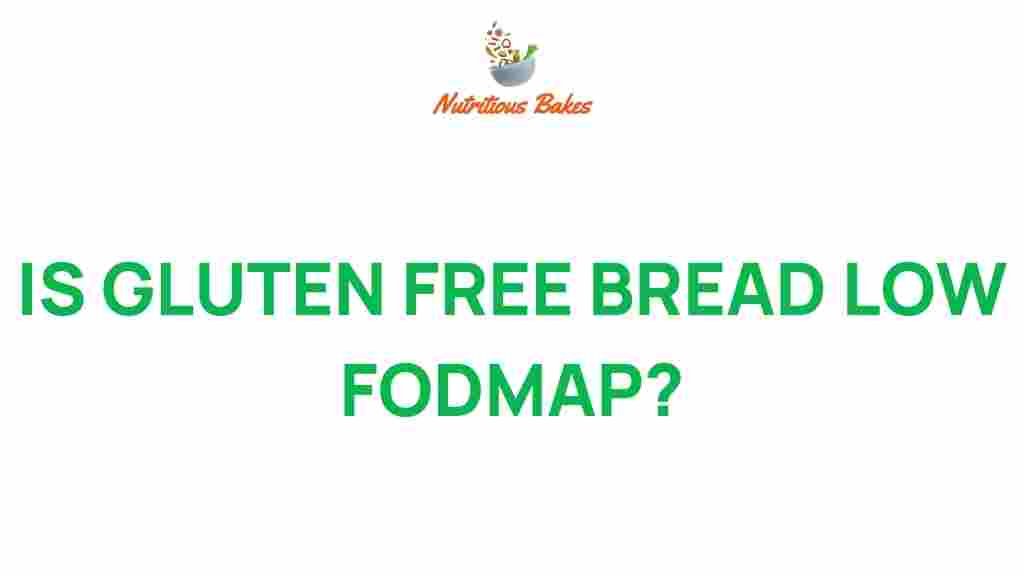Is Gluten-Free Bread a Low FODMAP Option?
In recent years, gluten-free bread has gained immense popularity, especially among those with food intolerances and digestive health concerns. However, as diets become more specialized, many individuals are left wondering: is gluten-free bread a low FODMAP option? This article will explore the relationship between gluten-free bread and the low FODMAP diet, offering insights and nutrition tips for those navigating dietary choices that promote gut health.
Understanding Gluten-Free Bread
Gluten-free bread is made without wheat, barley, or rye, which are the primary sources of gluten. Instead, it typically utilizes gluten alternatives like rice flour, almond flour, or tapioca starch. While gluten-free bread is a suitable choice for those with celiac disease or non-celiac gluten sensitivity, it’s essential to consider how these ingredients affect those who are following a low FODMAP diet.
What is the Low FODMAP Diet?
The low FODMAP diet is designed to help individuals manage symptoms related to food intolerances, particularly irritable bowel syndrome (IBS). FODMAP stands for Fermentable Oligosaccharides, Disaccharides, Monosaccharides, and Polyols, which are types of carbohydrates that can cause digestive distress in some people. The diet involves three phases: elimination, reintroduction, and personalization.
FODMAPs in Gluten-Free Bread
Many gluten-free breads contain ingredients that may be high in FODMAPs. Here are some common ingredients found in gluten-free bread and their FODMAP content:
- Rice Flour: Low FODMAP
- Almond Flour: Low FODMAP in moderation
- Tapioca Starch: Low FODMAP
- Chickpea Flour: High FODMAP
- Honey: High FODMAP
- Agave Syrup: High FODMAP
As you can see, not all gluten-free breads are created equal. It’s crucial to read labels carefully and choose options that are low FODMAP if you’re trying to manage digestive health.
Choosing Low FODMAP Gluten-Free Bread
When selecting gluten-free bread that aligns with a low FODMAP diet, consider the following nutrition tips:
- Read Labels: Look for breads made with low FODMAP ingredients.
- Portion Control: Some ingredients may be low FODMAP in small amounts but can become high FODMAP if consumed in larger portions.
- Homemade Options: Consider making your own gluten-free bread using low FODMAP flours like rice or tapioca.
- Check for Added Ingredients: Avoid breads with added sweeteners or high FODMAP additives.
Step-by-Step Guide to Making Low FODMAP Gluten-Free Bread
If you’re interested in making your own gluten-free bread that is also low FODMAP, follow this simple recipe:
Ingredients:
- 2 cups rice flour
- 1 cup tapioca starch
- 1 teaspoon salt
- 1 tablespoon baking powder
- 2 cups water
- 1 tablespoon olive oil (optional)
Instructions:
- Preheat the Oven: Preheat your oven to 350°F (175°C).
- Mix Dry Ingredients: In a bowl, combine the rice flour, tapioca starch, salt, and baking powder.
- Add Wet Ingredients: Slowly mix in the water and olive oil until you achieve a thick batter.
- Prepare the Loaf Pan: Grease a loaf pan or line it with parchment paper.
- Pour the Batter: Pour the batter into the prepared loaf pan.
- Bake: Bake for 45-50 minutes or until the bread is golden brown and a toothpick inserted comes out clean.
- Cool and Slice: Allow the bread to cool before slicing.
This simple recipe allows you to enjoy gluten-free bread while adhering to a low FODMAP diet, ensuring that your dietary choices support your digestive health.
Troubleshooting Tips for Gluten-Free Bread
Making gluten-free bread can come with its challenges. Here are some troubleshooting tips to help you achieve the perfect loaf:
- Texture Issues: If your bread is too dense, try adding more liquid or using a combination of flours.
- Flavor Concerns: Experiment with adding herbs or spices to enhance the taste.
- Moisture Problems: If the bread is too dry, consider adding a bit more oil or using a different flour blend.
Storing Gluten-Free Bread
Proper storage is crucial for maintaining the freshness of your gluten-free bread. Here are some tips:
- Room Temperature: Store in an airtight container for up to 3 days.
- Freezing: Slice the bread and wrap it in plastic wrap, then place it in a freezer bag for up to 3 months.
- Toasting: Frozen bread can be toasted directly from the freezer for a quick meal or snack.
Conclusion: Making Informed Dietary Choices
In summary, gluten-free bread can be a low FODMAP option, but it heavily depends on the ingredients used. By carefully selecting your gluten-free bread and understanding the low FODMAP guidelines, you can enjoy delicious and gut-friendly foods that support your digestive health.
As you explore gluten alternatives, remember to prioritize your dietary choices based on your individual food intolerances and preferences. For more information on managing digestive health through diet, consider visiting this resource or check out this article for further insights.
With the right knowledge and tools, you can navigate the world of gluten-free and low FODMAP foods with confidence, enjoying a healthier, happier gut!
This article is in the category Diet and created by NutritiousBakes Team
